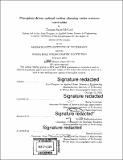Perception-driven optimal motion planning under resource constraints
Author(s)
Sayre-McCord, Thomas(Roswell Thomas)
Download1102316332-MIT.pdf (10.29Mb)
Other Contributors
Joint Program in Applied Ocean Science and Engineering.
Massachusetts Institute of Technology. Department of Mechanical Engineering.
Woods Hole Oceanographic Institution.
Advisor
Sertac Karaman.
Terms of use
Metadata
Show full item recordAbstract
Over the past few years there has been a new wave of interest in fully autonomous robots operating in the real world, with applications from autonomous driving to search and rescue. These robots are expected to operate at high speeds in unknown, unstructured environments using only onboard sensing and computation, presenting significant challenges for high performance autonomous navigation. To enable research in these challenging scenarios, the first part of this thesis focuses on the development of a custom high-performance research UAV capable of high speed autonomous flight using only vision and inertial sensors. This research platform was used to develop stateof- the-art onboard visual inertial state estimation at high speeds in challenging scenarios such as flying through window gaps. While this platform is capable of high performance state estimation and control, its capabilities in unknown environments are severely limited by the computational costs of running traditional vision-based mapping and motion planning algorithms on an embedded platform. Motivated by these challenges, the second part of this thesis presents an algorithmic approach to the problem of motion planning in an unknown environment when the computational costs of mapping all available sensor data is prohibitively high. The algorithm is built around a tree of dynamically feasible and free space optimal trajectories to the goal state in configuration space. As the algorithm progresses it iteratively switches between processing new sensor data and locally updating the search tree. We show that the algorithm produces globally optimal motion plans, matching the optimal solution for the case with the full (unprocessed) sensor data, while only processing a subset of the data. The mapping and motion planning algorithm is demonstrated on a number of test systems, with a particular focus on a six-dimensional thrust limited model of a quadrotor.
Description
Thesis (Ph. D.)--Joint Program in Applied Ocean Science and Engineering (Massachusetts Institute of Technology, Department of Mechanical Engineering; and the Woods Hole Oceanographic Institution), 2019 Cataloged from PDF version of thesis. Includes bibliographical references (pages 105-112).
Date issued
2019Department
Joint Program in Applied Ocean Science and Engineering; Massachusetts Institute of Technology. Department of Mechanical Engineering; Woods Hole Oceanographic InstitutionPublisher
Massachusetts Institute of Technology
Keywords
Joint Program in Applied Ocean Science and Engineering., Mechanical Engineering., Woods Hole Oceanographic Institution.